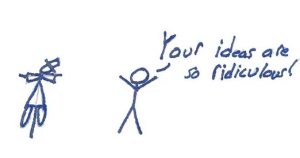8
Logical Fallacies
As the word “fallacy” suggests, a logical fallacy is a “falsehood,” or an error in logic or reasoning. You need to know fallacies so you can avoid them in your writing and spot them in others’ writing.
Some writers and argument theorists divide fallacies into the categories of the rhetorical triangle (fallacies of logos, of ethos, of pathos), but no matter what kind of thing they are, they represent a flaw – perhaps fuzzy thinking, perhaps laziness, perhaps intent to derail the argument.
The identification of many logical fallacies goes back at least to the Romans – which is why several of them are better known by their Latin names — but fear not: you will know them by their traits no matter the name.
There are many fallacies, so this list is not exhaustive, and perhaps your instructor will add others, but this list will get you started and give you a sense of the nature of the problems.
- Ad hominem (“to the person”). When an arguer makes personal attacks, this is the ad hominem fallacy. When a person says
 about an opponent, for instance, that she “is a wacky nut job” or “is crazed or incompetent” or “looks like a snowman,” or “had blood coming out of her eyes, out of her wherever,” those are all personal insults that have nothing to do with the argument. You are arguing with someone’s ideas, not the person. Do not substitute childish name-calling for actual argumentation. The same applies to a person’s affiliations or traits, for example: unless there is something very specific to the argument, it is not relevant if the arguer is a Christian, or Buddhist, or vegan, etc.
about an opponent, for instance, that she “is a wacky nut job” or “is crazed or incompetent” or “looks like a snowman,” or “had blood coming out of her eyes, out of her wherever,” those are all personal insults that have nothing to do with the argument. You are arguing with someone’s ideas, not the person. Do not substitute childish name-calling for actual argumentation. The same applies to a person’s affiliations or traits, for example: unless there is something very specific to the argument, it is not relevant if the arguer is a Christian, or Buddhist, or vegan, etc.
- Post hoc, ergo propter hoc (“after this, therefore because of this”). This fallacy is particularly common to causal arguments as it is an error of sequencing. To commit this mistake is to confuse chronology (time) with causality. Just because Event A occurred in time first does not mean it had anything to do with Event B. I had a friend once who swore his gas mileage im
 proved after he turned off the fog lights on his car, but since the lights do not run on gas, there is probably not a causal connection there. It is important to mark that A may, indeed, have helped lead to B, but that is what the causal argument is supposed to prove; as a responsible arguer, you cannot simply say “B happened after A, so A must have caused B.” When a person says, for instance, “Without me, the Olympics would have been a failure” or suggests that because of him “oil prices are falling,” without offering any actual evidence of a causal connection, that is the post hoc fallacy.
proved after he turned off the fog lights on his car, but since the lights do not run on gas, there is probably not a causal connection there. It is important to mark that A may, indeed, have helped lead to B, but that is what the causal argument is supposed to prove; as a responsible arguer, you cannot simply say “B happened after A, so A must have caused B.” When a person says, for instance, “Without me, the Olympics would have been a failure” or suggests that because of him “oil prices are falling,” without offering any actual evidence of a causal connection, that is the post hoc fallacy.
- Reductio ad absurdum (“reduction to the absurd”). “Taking things to extremes” might be another way to explain this. It is a
 way to make an argument look bizarre or unsuitable by extending the logic of the argument beyond the sensible ending point. Maybe you have suggested to a friend that eating less would be more healthy; if your friend responds by saying “Well, then I guess eating nothing would be healthiest of all!,” your friend has embraced the absurd in order to avoid dealing with the actual suggestion of dieting. Do not hyperextend an argument; take it on its own terms.
way to make an argument look bizarre or unsuitable by extending the logic of the argument beyond the sensible ending point. Maybe you have suggested to a friend that eating less would be more healthy; if your friend responds by saying “Well, then I guess eating nothing would be healthiest of all!,” your friend has embraced the absurd in order to avoid dealing with the actual suggestion of dieting. Do not hyperextend an argument; take it on its own terms.
- Non sequitur (“it does not follow”). This fallacy occurs when an arguer answers a claim or evidence with something that is not clearly related or perhaps even non-sensical. In that way, it may closely be related to the red herring fallacy (see below),
 but it is not so much an attempt to change the subject as a demonstration that the arguer may not really understand or take seriously the claim in question or may simply be skipping over important missing steps. Suppose a student said to Professor P, “You should be wearing a turtleneck sweater because all my other English professors have worn turtleneck sweaters.” While colleagues may share a similar sense of suitable clothes, they also may not, and what E wears has little impact on what P should be wearing. To make that argument would require more evidence and logical connection. If you were pulled over for speeding and said to the officer, “Please don’t give me ticket; I love puppies!,” you would get a speeding ticket, and for good reasons.[1]
but it is not so much an attempt to change the subject as a demonstration that the arguer may not really understand or take seriously the claim in question or may simply be skipping over important missing steps. Suppose a student said to Professor P, “You should be wearing a turtleneck sweater because all my other English professors have worn turtleneck sweaters.” While colleagues may share a similar sense of suitable clothes, they also may not, and what E wears has little impact on what P should be wearing. To make that argument would require more evidence and logical connection. If you were pulled over for speeding and said to the officer, “Please don’t give me ticket; I love puppies!,” you would get a speeding ticket, and for good reasons.[1]
- Tu quoque[2] (“and you also”). Often also called “whataboutery” because that is so often how it is phrased, this fallacy is an attempt to deflect attention from one thing back onto the person who made the counter claim or some other party. Back to the traffic stop for a moment: if the officer tells you that you were speeding, and your response is “so was everybody else,”
 you have tried the tu quoque fallacy. What makes this reasoning fallacious is that even if true, it has no bearing on your driving: you were still speeding. This tactic is something a person employs when there is no substantial defense, so an aggressive offense looks better than acknowledging the truth of the initial claim. When a person’s political ally was indicted for lying to Congress and the person asked “What about all the lying of” X, Y, and Z, that is a fallacy; when a person defended the brutality of a foreign leader by saying “What, you think our country’s so innocent?,” that is a fallacy. If it sounds like the kind of taunt a kid might offer, then you are probably close. The same kind of fuzzy thinking applies if A says something like “Skateboarding isn’t a sport” and B replies, “Well, you couldn’t do it.” Whether the initial speaker can or cannot is not what makes a sport, but tu quoque is an attempt to create doubt through insinuation and distraction.
you have tried the tu quoque fallacy. What makes this reasoning fallacious is that even if true, it has no bearing on your driving: you were still speeding. This tactic is something a person employs when there is no substantial defense, so an aggressive offense looks better than acknowledging the truth of the initial claim. When a person’s political ally was indicted for lying to Congress and the person asked “What about all the lying of” X, Y, and Z, that is a fallacy; when a person defended the brutality of a foreign leader by saying “What, you think our country’s so innocent?,” that is a fallacy. If it sounds like the kind of taunt a kid might offer, then you are probably close. The same kind of fuzzy thinking applies if A says something like “Skateboarding isn’t a sport” and B replies, “Well, you couldn’t do it.” Whether the initial speaker can or cannot is not what makes a sport, but tu quoque is an attempt to create doubt through insinuation and distraction.
- Hasty generalization. A fallacy of inductive reasoning, the hasty generalization occurs when the writer or speaker arrives at a conclusion based on too few examples. How many are too few? That determination must depend on the size of the group being generalized – if there are only, say, fourteen universities in the SEC, and you have provided some evidence that several
 are primarily known for sports, you are probably pretty safe in expanding that; you could responsibly say “For the most part,[3] the SEC is a sports-first conference.” But if your generalized group has hundreds, or thousands, or perhaps even millions of members, relying only on six or dozen examples is fallacious. Obviously, you cannot always provide examples for something like twenty-five percent, but when you are making a general statement, you need to have reasonable evidence that your examples are, in fact, typical of the whole. When a person says that all the immigrants – thousands and thousands of them — from a particular country are “bringing drugs, bringing crime, they’re rapists” or that all the people in a peaceful protest are “terrorists who hate America,” those are fallacies.
are primarily known for sports, you are probably pretty safe in expanding that; you could responsibly say “For the most part,[3] the SEC is a sports-first conference.” But if your generalized group has hundreds, or thousands, or perhaps even millions of members, relying only on six or dozen examples is fallacious. Obviously, you cannot always provide examples for something like twenty-five percent, but when you are making a general statement, you need to have reasonable evidence that your examples are, in fact, typical of the whole. When a person says that all the immigrants – thousands and thousands of them — from a particular country are “bringing drugs, bringing crime, they’re rapists” or that all the people in a peaceful protest are “terrorists who hate America,” those are fallacies.
- Either/or (or, “the false dilemma”). Sometimes in life, there really are only two choices; you might go to a wedding reception, for example, and the server might ask you “meat lasagna or spinach lasagna?” If you say, “prime rib,” they are not suddenly going to magic some up for you. But that is not usually the case; life is complex and there are rarely only two choices. Even with the reception menu, you could choose not to eat! You could choose to smuggle in some Taco Bell instead.
 Because life is complex and choices are numerous, it is a fallacy to try to reduce some set of choices down to two. In the classic form of this fallacy, even one of those two choices is bad, essentially leaving the reader with one choice, which is not a choice at all. In 2004, Vice-President Dick Cheney said at a campaign stop, “You can either re-elect President Bush, or you can have more terrorist attacks.” Does anyone here want more terrorist attacks? Of course not, so that would only leave one possibility. But in the non-fallacy world, it is possible to have a new president and no terrorist attacks or to keep the old president and still have new terrorist attacks; see, lots of choices. I once asked my younger daughter if she wanted to brush her teeth first or pick up her toys first, and she picked “Eat a snack.” Even children understand the falsity of only two choices. When a person says North Korea can “either denuclearize or face fire and fury like the world has never seen,” that is not the complete list; neither of those things has happened, after all.
Because life is complex and choices are numerous, it is a fallacy to try to reduce some set of choices down to two. In the classic form of this fallacy, even one of those two choices is bad, essentially leaving the reader with one choice, which is not a choice at all. In 2004, Vice-President Dick Cheney said at a campaign stop, “You can either re-elect President Bush, or you can have more terrorist attacks.” Does anyone here want more terrorist attacks? Of course not, so that would only leave one possibility. But in the non-fallacy world, it is possible to have a new president and no terrorist attacks or to keep the old president and still have new terrorist attacks; see, lots of choices. I once asked my younger daughter if she wanted to brush her teeth first or pick up her toys first, and she picked “Eat a snack.” Even children understand the falsity of only two choices. When a person says North Korea can “either denuclearize or face fire and fury like the world has never seen,” that is not the complete list; neither of those things has happened, after all.
- Bandwagon (or, the appeal to popularity). There is a famous greatest hits collection of Elvis Presley’s called Fifty Million Elvis Fans Can’t Be Wrong. Well, actually, yes, they can. Just because a lot of people believe something does not make it so. There is a sign often seen in Sunday School classrooms that says, “The popular thing is not always right, and the right thing is not
 always popular.” It is a reminder that mass appeal does not equal correct action or belief. This fallacy is common in many places, but it is often made in popular culture, when box office or other sales totals are offered as evidence of artistic quality. “What do you mean Action Adventure Film was a bad movie? It made 400 million dollars!” “How dare you say Billie Eilish is overrated – she has 65.5 million Instagram followers!” But those are separate questions; both things – low quality and high popularity – can be true, just as the reverse can be true. When a person says, “everybody knows [Russian meddling] had no impact on votes in this election” or “everybody knows that walls work,” or repeats “many people are saying” without ever citing who those people are, those are fallacies, and that person is trying to crowd everybody onto the bandwagon.
always popular.” It is a reminder that mass appeal does not equal correct action or belief. This fallacy is common in many places, but it is often made in popular culture, when box office or other sales totals are offered as evidence of artistic quality. “What do you mean Action Adventure Film was a bad movie? It made 400 million dollars!” “How dare you say Billie Eilish is overrated – she has 65.5 million Instagram followers!” But those are separate questions; both things – low quality and high popularity – can be true, just as the reverse can be true. When a person says, “everybody knows [Russian meddling] had no impact on votes in this election” or “everybody knows that walls work,” or repeats “many people are saying” without ever citing who those people are, those are fallacies, and that person is trying to crowd everybody onto the bandwagon.
- Appeal to tradition/appeal to novelty. These parallel fallacies are the flip side of the same kind of thinking – and that thinking is not based in evidence or logic. If you have ever heard anyone justify some course of action by saying some version of, “that’s how we’ve done it for years,” then you have heard someone offer the appeal to tradition. Doing a thing one way for X
 number of years is not a justification for continuing to do it. Again, that does not mean there are no reasons to keep doing it: maybe it makes people happy, maybe it is cheap and effective, maybe it allows for the widest participation, etc. In that case, though, those are the reasons, not the tradition. “Do it again and again without thinking” can hardly be a sound strategy. The same is true at the other end of the spectrum, though; if you have every heard someone say, “We should try thing X because we never have before!” that is the appeal to novelty. Just because something is new is no more a reason than because it is old. Again, there might be good reasons to try something new: maybe you are tired of the food at your favorite restaurant, so you decide to try Indian food. But, again, the being tired of the food is the reason, not the newness of the curries. New is not always better, as the makers of New Coke could tell you, or anyone who has to struggle with new “updates” to a favorite program that seem to exist just to be different than what came before; my children complain that Instagram is not chronological anymore, for instance.
number of years is not a justification for continuing to do it. Again, that does not mean there are no reasons to keep doing it: maybe it makes people happy, maybe it is cheap and effective, maybe it allows for the widest participation, etc. In that case, though, those are the reasons, not the tradition. “Do it again and again without thinking” can hardly be a sound strategy. The same is true at the other end of the spectrum, though; if you have every heard someone say, “We should try thing X because we never have before!” that is the appeal to novelty. Just because something is new is no more a reason than because it is old. Again, there might be good reasons to try something new: maybe you are tired of the food at your favorite restaurant, so you decide to try Indian food. But, again, the being tired of the food is the reason, not the newness of the curries. New is not always better, as the makers of New Coke could tell you, or anyone who has to struggle with new “updates” to a favorite program that seem to exist just to be different than what came before; my children complain that Instagram is not chronological anymore, for instance.
- Appeal to ignorance. “You can’t prove I’m wrong” might be another way to think of this fallacy. If a friend made the claim that aliens had briefly possessed the bodies of several prominent people and offered no evidence in the positive but simply pointed out the lack of any contrary evidence, that is called the appeal to ignorance because it relies on our not knowing
 things. When claims cannot be tested or disproved, we are left with nothing but doubts. Suppose that during the recent wave of states approving marijuana for medical or recreational purposes, somebody made the claim “If Thomas Jefferson were alive today, he would want us to legalize marijuana.” Jefferson – not surprisingly – left no such explicit statements in his writings, so that leaves us with no guidance on what he “would want.” We cannot disprove that claim, true, but that should not constitute evidence. When a person says, “you have no evidence my campaign did not suffer from voter fraud,” that is a fallacy.
things. When claims cannot be tested or disproved, we are left with nothing but doubts. Suppose that during the recent wave of states approving marijuana for medical or recreational purposes, somebody made the claim “If Thomas Jefferson were alive today, he would want us to legalize marijuana.” Jefferson – not surprisingly – left no such explicit statements in his writings, so that leaves us with no guidance on what he “would want.” We cannot disprove that claim, true, but that should not constitute evidence. When a person says, “you have no evidence my campaign did not suffer from voter fraud,” that is a fallacy.
- Red herring. What does a fish have to do with rhetorical fallacies? Cool story – poachers, or other reprobates, might have had any number of reasons to want to cover their tracks when they were being chased through the forest, and one of the best/most malodorous ways was to take a pungent fish – like a herring – and drag it across the path. Thus the red herring
 fallacy is your classic “what’s that thing over there?!?” attempt at distraction. It is a changing of the subject to confuse or obstruct the argument. Several years ago in the Missouri Senate, there was a hearing on the economic impact on Missouri of immigration, legal or otherwise. At the hearing, one of the senators, after hearing about the money immigrants spend in the state, said “I don’t know why we’re focused on these numbers when there were so many abortions in the state last year.” What does one thing have to do with the other? Nothing, really; it is an attempt to derail the process. When the subject is a Congressional probe of Russian meddling in a US election and a person responds by writing “Obama made a terrible deal with Iran!,” that is a fallacy.
fallacy is your classic “what’s that thing over there?!?” attempt at distraction. It is a changing of the subject to confuse or obstruct the argument. Several years ago in the Missouri Senate, there was a hearing on the economic impact on Missouri of immigration, legal or otherwise. At the hearing, one of the senators, after hearing about the money immigrants spend in the state, said “I don’t know why we’re focused on these numbers when there were so many abortions in the state last year.” What does one thing have to do with the other? Nothing, really; it is an attempt to derail the process. When the subject is a Congressional probe of Russian meddling in a US election and a person responds by writing “Obama made a terrible deal with Iran!,” that is a fallacy.
- False analogy. Since an “analogy” is a comparison of things, a false analogy happens when an arguer compares – either deliberately or otherwise – two things that are not alike. Sometimes this is done in only one aspect of the comparison: you
 could credibly claim that Afghanistan or Iraq are like Vietnam in the sense that the United States has been there for a long time, there is little sense that our objectives will ultimately be achieved, and there is no “winning” scenario to allow for a graceful exit. If you want to make that comparison, fine, but qualify it; if you say “Afghanistan is like Vietnam” and leave it at that, you immediately open yourself to claims of false analogy because they are most definitely not alike in terrain, climate, intensity of casualties, etc. In fact, the US military was in Afghanistan for twice as long as it was in Vietnam, so even that comparison is becoming weaker. If an anti-marijuana crusader compared it to heroin or meth, you could point out the false analogy. When a person says about protestors at a Neo-Nazi rally that “you also had some very fine people on both sides,” that is drawing a similarity between Nazis (who are by definition “not nice”) and not Nazis, and it is thus a fallacy.
could credibly claim that Afghanistan or Iraq are like Vietnam in the sense that the United States has been there for a long time, there is little sense that our objectives will ultimately be achieved, and there is no “winning” scenario to allow for a graceful exit. If you want to make that comparison, fine, but qualify it; if you say “Afghanistan is like Vietnam” and leave it at that, you immediately open yourself to claims of false analogy because they are most definitely not alike in terrain, climate, intensity of casualties, etc. In fact, the US military was in Afghanistan for twice as long as it was in Vietnam, so even that comparison is becoming weaker. If an anti-marijuana crusader compared it to heroin or meth, you could point out the false analogy. When a person says about protestors at a Neo-Nazi rally that “you also had some very fine people on both sides,” that is drawing a similarity between Nazis (who are by definition “not nice”) and not Nazis, and it is thus a fallacy.
- Slippery slope. This fallacy attempts to claim that once we begin a particular course of action, there is no place to stop; it will be straight down to the bottom from here. If the anti-marijuana crusader from our above example says “If we legalize
 marijuana, then we’ll have to legalize opium, then heroin, then meth, and then we’ll all be drug addicts!,” that person is arguing the slippery slope. When the NRA says there should be no limit on the number of guns a person can own because “four becomes two, which becomes one, which becomes none,”[4] that is a slippery slope. When a fundamentalist preacher said, “If we let gay couples marry, next we’ll have to let people marry livestock,” not only was that the slippery slope, but it mashed up the false analogy into a big fallacious ball. When a person says about taking down Confederate statues “This week it’s Robert E. Lee. I notice that Stonewall Jackson’s coming down. I wonder; is it George Washington next week, and is it Thomas Jefferson[5] the week after? You know, you really do have to ask yourself, where does it stop?,” that is the slippery slope fallacy because in the real world, there are many good places to stop before any sense of “the bottom” is reached.
marijuana, then we’ll have to legalize opium, then heroin, then meth, and then we’ll all be drug addicts!,” that person is arguing the slippery slope. When the NRA says there should be no limit on the number of guns a person can own because “four becomes two, which becomes one, which becomes none,”[4] that is a slippery slope. When a fundamentalist preacher said, “If we let gay couples marry, next we’ll have to let people marry livestock,” not only was that the slippery slope, but it mashed up the false analogy into a big fallacious ball. When a person says about taking down Confederate statues “This week it’s Robert E. Lee. I notice that Stonewall Jackson’s coming down. I wonder; is it George Washington next week, and is it Thomas Jefferson[5] the week after? You know, you really do have to ask yourself, where does it stop?,” that is the slippery slope fallacy because in the real world, there are many good places to stop before any sense of “the bottom” is reached.
- Straw man. Much beloved by politicians of all sorts, this fallacy attacks opponents for things they did not really say or creates a cartoonish version of their actual arguments. The idea here is to set up a dummy that is easily dismissed and knocked
 down, hence the straw man. In its fullest form, this fallacy’s version of the opposition argument is indefensible or wildly unpleasant, making it that much easier to diminish. If I argued that marijuana should be fully legal, and you said, “That guy wants everybody to smoke dope!,” you would be misrepresenting what I said in order to ridicule my actual claim and thereby avoid having to address the complications of the real argument. When a person says the opposition wants to “open our borders to floods of drugs and ruthless gangs,” that is a fallacy.
down, hence the straw man. In its fullest form, this fallacy’s version of the opposition argument is indefensible or wildly unpleasant, making it that much easier to diminish. If I argued that marijuana should be fully legal, and you said, “That guy wants everybody to smoke dope!,” you would be misrepresenting what I said in order to ridicule my actual claim and thereby avoid having to address the complications of the real argument. When a person says the opposition wants to “open our borders to floods of drugs and ruthless gangs,” that is a fallacy.
- Circular reasoning (“begging the question”). Do you know that old joke about a leading question that asks, “When did you stop beating your wife?” It might come in many forms; you might be asked “When did you stop abusing drugs?” Or, you
 could go darker and assume the person is still at it: “When did you start kicking puppies?” See how those constructions presume the very thing they are asking about? The wife-beating, the drug-abusing, the puppy-kicking? That kind of inescapable framing is a fallacy because it is working in a circle, just repeating the original idea but in slightly different form. If I said, “I’m overweight because I’m fat” or “Soccer is the best sport because it’s the only one that uses a soccer ball,” all I have done is gone right back around to where I began.
could go darker and assume the person is still at it: “When did you start kicking puppies?” See how those constructions presume the very thing they are asking about? The wife-beating, the drug-abusing, the puppy-kicking? That kind of inescapable framing is a fallacy because it is working in a circle, just repeating the original idea but in slightly different form. If I said, “I’m overweight because I’m fat” or “Soccer is the best sport because it’s the only one that uses a soccer ball,” all I have done is gone right back around to where I began.
Again, be alive to potential logical fallacies in your own work, and be prepared to point them out when rebutting the work of others.
- Assuming you were really speeding, of course. ↵
- Pronounced “too kwo-kway.” ↵
- And what do we call this thing that limits the scope of the claim? And it needs to be qualified because we do not want to overlook Vanderbilt! ↵
- Charlton Heston, then NRA President, offered this tactic on the Sunday morning news show This Week. As with all fallacies, there may be sound reasons not to do something, but the slippery slope is not among them. ↵
- If comparing US founders to Confederate military figures also seems like the false analogy, now you’re getting it. ↵
